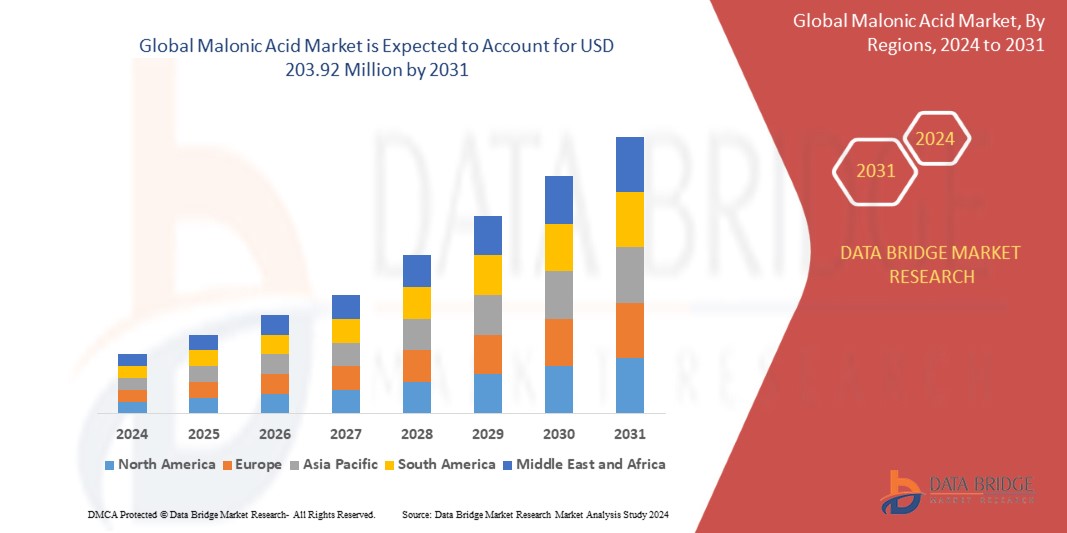世界のマロン酸市場の規模、シェア、トレンド分析レポート
Market Size in USD Billion
CAGR :
% 
| 2024 –2031 | |
| USD 154.86 Million | |
| USD 203.92 Million | |
|
|
|
>世界のマロン酸市場の区分、グレード別(テクニカルグレード、食品グレード)、用途別(前駆体、ポリマー、特殊化学品、添加剤、風味増強剤)、エンドユーザー別(化学産業、医薬品、化粧品、電子機器) - 2031年までの業界動向と予測。
マロン酸市場分析
マロン酸は、その化学的性質と汎用性から、さまざまな用途に広く使用されています。医薬品では、バルビツール酸や特定の抗がん剤などの薬物の合成において重要な中間体として機能します。安定した複合体を形成し、構成要素として機能する能力があるため、薬物製剤において貴重です。食品業界では、製品の安定性を維持し、味を高める酸性特性があるため、マロン酸は天然の防腐剤および香料として使用されています。農業では、マロン酸は、害虫駆除や作物管理に不可欠なイネペスチンなどの殺菌剤やインジルエステルなどの植物成長調整剤の製造に不可欠です。さらに、生分解性プラスチックの製造におけるマロン酸の役割は、環境に優しい材料の開発におけるその重要性を際立たせています。その幅広い用途は、複数の業界での化学的汎用性と重要性を強調しています。
マロン酸市場規模
世界のマロン酸市場規模は、2023年に1億5,486万米ドルと評価され、2024年から2031年の予測期間中に3.5%のCAGRで成長し、2031年には2億392万米ドルに達すると予測されています。市場価値、成長率、セグメンテーション、地理的範囲、主要プレーヤーなどの市場シナリオに関する洞察に加えて、Data Bridge Market Researchがまとめた市場レポートには、詳細な専門家分析、患者の疫学、パイプライン分析、価格分析、規制枠組みも含まれています。
マロン酸市場の動向
「生分解性プラスチックの生産における使用の増加」
環境への懸念が高まり、プラスチック廃棄物の規制が厳しくなるにつれて、持続可能な材料への移行が進んでいます。マロン酸は、ポリリンゴ酸などの生分解性ポリマーの合成における主要なモノマーとして使用されています。これらのポリマーは従来のプラスチックよりも簡単に分解されるため、環境への影響が軽減されます。この市場の拡大は、グリーンケミストリーと環境に優しい材料への幅広い推進を反映しています。企業や研究者は、マロン酸を利用してより持続可能なプラスチックの代替品を開発する技術に投資しており、これは世界的な持続可能性の目標と一致しており、市場の成長の重要なトレンドとなっています。
レポートの範囲とマロン酸市場のセグメンテーション
|
レポートメトリック |
マロン酸市場の洞察 |
|
対象セグメント |
|
|
対象国 |
米国、カナダ、メキシコ、ドイツ、フランス、英国、オランダ、スイス、ベルギー、ロシア、イタリア、スペイン、トルコ、その他のヨーロッパ諸国、中国、日本、インド、韓国、シンガポール、マレーシア、オーストラリア、タイ、インドネシア、フィリピン、その他のアジア太平洋諸国、サウジアラビア、UAE、南アフリカ、エジプト、イスラエル、その他の中東およびアフリカ諸国、ブラジル、アルゼンチン、その他の南米諸国 |
|
主要な市場プレーヤー |
BASF SE(ドイツ)、セラニーズコーポレーション(米国)、デュポン(米国)、イーストマンケミカルカンパニー(米国)、エボニックインダストリーズAG(ドイツ)、INEOSグループ(英国)、ロンザグループ(スイス)、メルクKGaA(ドイツ)、シグマアルドリッチコーポレーション(米国)、ソルベイSA(ベルギー) |
|
市場機会 |
|
|
付加価値データ情報セット |
Data Bridge Market Research がまとめた市場レポートには、市場価値、成長率、セグメンテーション、地理的範囲、主要プレーヤーなどの市場シナリオに関する洞察に加えて、輸出入分析、生産能力の概要、生産消費分析、価格動向分析、気候変動シナリオ、サプライ チェーン分析、バリュー チェーン分析、原材料/消耗品の概要、ベンダー選択基準、PESTLE 分析、ポーター分析、規制枠組みも含まれています。 |
マロン酸市場の定義
マロン酸は、化学式 C3H4O4 のジカルボン酸です。主に有機合成の構成要素として使用されます。医薬品では、賦形剤として使用され、薬剤の配合に関与します。食品業界では、マロン酸は天然の保存料および香料として機能します。また、農業では、米ペスチンなどの殺菌剤やインジルエステルなどの植物成長調整剤の製造における中間体として使用されています。その汎用性は、さまざまな化学反応の試薬として機能する実験室用途にまで及びます。
マロン酸市場の動向
ドライバー
- 食品・飲料分野での応用拡大
マロン酸は、さまざまな食品や飲料製品で、香味料、pH 調整剤、防腐剤としてますます使用されています。風味を高め、pH レベルを安定させる能力があるため、飲料、焼き菓子、加工食品の製造に重宝されています。高品質で長持ちする食品に対する消費者の需要が高まっているため、メーカーはマロン酸を配合に取り入れるようになりました。さらに、クリーンラベルや天然由来の成分への傾向により、再生可能な資源から得られるマロン酸の使用が増加しています。たとえば、ATAMAN KİMYA によると、マロン酸は食品や医薬品の用途で酸度を調整するために使用されています。医薬品の処方では賦形剤として、食品では天然の防腐剤として使用されています。さらに、マロン酸は一部の食品で香味料として使用されています。
食品および飲料分野でのこうした用途の増加は、特に食品の品質と安全性が重視される北米やヨーロッパなどの地域で、マロン酸の需要増加に大きく貢献し、市場拡大の重要な原動力となっています。
- 製薬業界からの需要増加
マロン酸は、バルビツール酸、非ステロイド性抗炎症薬(NSAID)、ビタミンB1やB6などのビタミンを含むさまざまな医薬品の合成において重要な中間体です。薬物合成、特に治療特性を持つ複雑な分子の生成におけるその役割により、マロン酸は医薬品製造に不可欠なものとなっています。慢性疾患の世界的な蔓延と新薬の継続的な開発により、マロン酸の需要が高まっています。さらに、製薬業界が費用対効果が高く効率的な製造プロセスに重点を置いていることから、マロン酸などの信頼性が高く高品質の中間体に対するニーズがさらに高まっています。この傾向は、革新的で効果的な医薬品の需要が高まり続けている北米やヨーロッパなどの先進的な医薬品セクターを持つ地域で特に顕著であり、マロン酸市場の拡大を促進しています。
機会
- 農薬業界におけるマロン酸誘導体の需要増加
ジエチルマロネートなどのマロン酸誘導体は、除草剤、殺虫剤、殺菌剤など、さまざまな農薬の合成に不可欠な中間体です。これらの化合物は、農薬配合物の効能と安定性を高め、害虫や病気から作物を保護する効果を高めます。増加する人口の食糧需要を満たす必要性から、世界の農業部門は作物の収穫量と品質の向上に重点を置いており、高度な農薬の使用が増加しています。その結果、マロン酸誘導体の需要が急増し、マロン酸市場に直接利益をもたらしています。たとえば、ATAMAN KİMYAによると、農業では、マロン酸は殺菌剤の米ペスチンと植物成長調整剤のインジルエステルの製造の中間体として機能します。
この傾向は、持続可能で効率的な農業慣行に重点が置かれている北米やアジア太平洋地域など、農業活動が盛んな地域で特に顕著です。
- エレクトロニクスおよびナノテクノロジーアプリケーションでの使用の増加
マロン酸とその誘導体は、電子デバイスやナノテクノロジーで使用される先端材料の合成において重要な役割を果たしています。たとえば、マロン酸は導電性ポリマーの製造に使用され、これはフレキシブルエレクトロニクス、センサー、有機太陽電池に不可欠です。拡大する消費者向けエレクトロニクス市場とナノテクノロジーの進歩に牽引され、高性能電子部品の需要が高まっているため、マロン酸のような特殊な化学物質の需要が高まっています。さらに、ナノメディシンやナノエレクトロニクスなどの次世代技術の開発に不可欠なナノ材料の製造におけるマロン酸の役割も、その需要をさらに押し上げています。エレクトロニクスとナノテクノロジーの分野が進化し続けるにつれて、これらの用途におけるマロン酸の需要は増加することが予想され、特にアジア太平洋や北米などの技術開発が進んでいる地域では、市場拡大の大きな機会が提供されます。
制約/課題
- 特に医薬品および食品・飲料における厳格な規制要件
マロン酸とその誘導体は、これらの業界で使用される前に、厳格な安全性と品質の基準を満たす必要があります。米国の FDA や欧州の EFSA などの規制機関は、消費者の安全を確保するために、食品や医薬品における化学物質の使用に関する厳格なガイドラインを施行しています。これらの規制に準拠するには、広範なテスト、文書化、そして多くの場合、製造プロセスのコストのかかる調整が必要です。これらの要件により、製品開発が遅れ、メーカーのコストが増加する可能性があり、マロン酸ベースの製品を迅速に市場に投入することが困難になります。さらに、規制の変更や新しいガイドラインの導入により、不確実性が生まれ、マロン酸市場の成長が妨げられる可能性があります。
- 必須原材料の価格変動
マロン酸の生産は酢酸やシアノ酢酸などの主要原材料に大きく依存しており、これらの価格は原油価格の変動、サプライチェーンの混乱、関連産業の需要の変化などの要因により変動する可能性があります。これらの原材料のコストが上昇すると、マロン酸の生産コストが直接増加し、メーカーの利益率が圧迫されます。この変動により、企業がマロン酸の安定した価格を維持することが困難になり、市場の不安定化につながり、医薬品や食品・飲料などの業界のバイヤーとの長期契約に影響を与える可能性があります。さらに、予測できない原材料コストは、新しい生産能力や研究開発への投資を阻害し、市場の成長をさらに制限する可能性があります。この課題は、サプライチェーンの混乱がより頻繁に発生する地域、または原材料コストが世界市場の状況に非常に敏感な地域で特に顕著です。
この市場レポートでは、最近の新しい開発、貿易規制、輸出入分析、生産分析、バリュー チェーンの最適化、市場シェア、国内および現地の市場プレーヤーの影響、新たな収益源の観点から見た機会の分析、市場規制の変更、戦略的市場成長分析、市場規模、カテゴリ市場の成長、アプリケーションのニッチと優位性、製品の承認、製品の発売、地理的拡大、市場における技術革新などの詳細が提供されます。市場に関する詳細情報を取得するには、アナリスト ブリーフについて Data Bridge Market Research にお問い合わせください。当社のチームが、情報に基づいた市場決定を行い、市場の成長を実現できるようお手伝いします。
原材料不足と出荷遅延の影響と現在の市場シナリオ
Data Bridge Market Research は、市場の高水準な分析を提供し、原材料不足や出荷遅延の影響と現在の市場環境を考慮した情報を提供します。これは、戦略的な可能性を評価し、効果的な行動計画を作成し、企業が重要な決定を下すのを支援することにつながります。
標準レポートの他に、予測される出荷遅延からの調達レベルの詳細な分析、地域別の販売代理店マッピング、商品分析、生産分析、価格マッピングの傾向、調達、カテゴリパフォーマンス分析、サプライチェーンリスク管理ソリューション、高度なベンチマーク、その他の調達および戦略サポートのサービスも提供しています。
経済減速が製品の価格と入手可能性に及ぼす予想される影響
経済活動が減速すると、業界は打撃を受け始めます。DBMR が提供する市場洞察レポートとインテリジェンス サービスでは、景気後退が製品の価格設定と入手しやすさに及ぼす予測される影響が考慮されています。これにより、当社のクライアントは通常、競合他社より一歩先を行き、売上と収益を予測し、損益支出を見積もることができます。
マロン酸市場の範囲
市場は、グレード、アプリケーション、エンド ユーザーに基づいてセグメント化されています。これらのセグメント間の成長は、業界のわずかな成長セグメントの分析に役立ち、ユーザーに貴重な市場の概要と市場の洞察を提供し、コア市場アプリケーションを特定するための戦略的決定を下すのに役立ちます。
学年
- テクニカルグレード
- 食品グレード
応用
- 前駆
- ポリマー
- 特殊化学品
- 添加剤
- 風味増強剤
エンドユーザー
- 化学産業
- 医薬品
- 化粧品
- エレクトロニクス
マロン酸市場の地域分析
市場は分析され、市場規模の洞察と傾向は、上記のように国、グレード、アプリケーション、およびエンドユーザー別に提供されます。
市場に含まれる国は、米国、カナダ、メキシコ、ドイツ、フランス、英国、オランダ、スイス、ベルギー、ロシア、イタリア、スペイン、トルコ、その他のヨーロッパ諸国、中国、日本、インド、韓国、シンガポール、マレーシア、オーストラリア、タイ、インドネシア、フィリピン、その他のアジア太平洋諸国、サウジアラビア、UAE、南アフリカ、エジプト、イスラエル、その他の中東およびアフリカ諸国、ブラジル、アルゼンチン、その他の南米諸国です。
アジア太平洋地域は、その強力な製造基盤と、医薬品、農業、プラスチックにおける高い需要により、マロン酸市場を支配しています。中国やインドなどの国々は、大規模な工業生産、多額の投資、成長する最終用途産業によってこの優位性を推進し、この地域の市場リーダーシップを強化しています。
北米は、医薬品と生分解性プラスチックへの注目度の高まりにより、マロン酸市場で最も高い成長率を記録しています。この地域の強力な研究開発活動と、持続可能な材料と高度な医薬品製剤への需要の高まりが相まって、この急速な市場成長を牽引しています。
レポートの国別セクションでは、市場の現在および将来の傾向に影響を与える国内市場における個別の市場影響要因と規制の変更も提供しています。下流および上流のバリュー チェーン分析、技術動向、ポーターの 5 つの力の分析、ケース スタディなどのデータ ポイントは、個々の国の市場シナリオを予測するために使用される指標の一部です。また、国別データの予測分析を提供する際には、グローバル ブランドの存在と可用性、および地元および国内ブランドとの競争が激しいか少ないために直面する課題、国内関税と貿易ルートの影響も考慮されます。
マロン酸の市場シェア
市場競争環境では、競合他社ごとの詳細が提供されます。詳細には、会社概要、会社の財務状況、収益、市場の可能性、研究開発への投資、新しい市場への取り組み、世界的なプレゼンス、生産拠点と施設、生産能力、会社の強みと弱み、製品の発売、製品の幅と広さ、アプリケーションの優位性などが含まれます。提供される上記のデータ ポイントは、市場に関連する会社の焦点にのみ関連しています。
市場で活動しているマロン酸市場のリーダーは次のとおりです。
- BASF SE(ドイツ)
- セラニーズコーポレーション(米国)
- デュポン(米国)
- イーストマンケミカルカンパニー(米国)
- エボニック インダストリーズ AG (ドイツ)
- INEOSグループ(英国)
- ロンザグループ(スイス)
- メルクKGaA(ドイツ)
- シグマアルドリッチコーポレーション(米国)
- ソルベイSA(ベルギー)
マロン酸市場の最新動向
- 2021年3月、LygosはAgile BioFoundryと提携して、広範なマルチオミクスデータセットを作成し、酵母株をエンジニアリングしてマロン酸などの有機酸を生成するための機械学習を強化しました。このコラボレーションでは、有機酸酵母株とマロン酸生合成経路に関する専門知識を活用して、生産技術を最適化します。
- 2020年6月、ウィッシュカンパニーのブランドであるBy Wishtrendは、敏感肌向けにカスタマイズされた新しい美容液を発売しました。15%の純粋なビタミンCとマロン酸を配合し、優しく効果的なソリューションを提供します。
SKU-
世界初のマーケットインテリジェンスクラウドに関するレポートにオンラインでアクセスする
- インタラクティブなデータ分析ダッシュボード
- 成長の可能性が高い機会のための企業分析ダッシュボード
- カスタマイズとクエリのためのリサーチアナリストアクセス
- インタラクティブなダッシュボードによる競合分析
- 最新ニュース、更新情報、トレンド分析
- 包括的な競合追跡のためのベンチマーク分析のパワーを活用
調査方法
データ収集と基準年分析は、大規模なサンプル サイズのデータ収集モジュールを使用して行われます。この段階では、さまざまなソースと戦略を通じて市場情報または関連データを取得します。過去に取得したすべてのデータを事前に調査および計画することも含まれます。また、さまざまな情報ソース間で見られる情報の不一致の調査も含まれます。市場データは、市場統計モデルと一貫性モデルを使用して分析および推定されます。また、市場シェア分析と主要トレンド分析は、市場レポートの主要な成功要因です。詳細については、アナリストへの電話をリクエストするか、お問い合わせをドロップダウンしてください。
DBMR 調査チームが使用する主要な調査方法は、データ マイニング、データ変数が市場に与える影響の分析、および一次 (業界の専門家) 検証を含むデータ三角測量です。データ モデルには、ベンダー ポジショニング グリッド、市場タイムライン分析、市場概要とガイド、企業ポジショニング グリッド、特許分析、価格分析、企業市場シェア分析、測定基準、グローバルと地域、ベンダー シェア分析が含まれます。調査方法について詳しくは、お問い合わせフォームから当社の業界専門家にご相談ください。
カスタマイズ可能
Data Bridge Market Research は、高度な形成的調査のリーダーです。当社は、既存および新規のお客様に、お客様の目標に合致し、それに適したデータと分析を提供することに誇りを持っています。レポートは、対象ブランドの価格動向分析、追加国の市場理解 (国のリストをお問い合わせください)、臨床試験結果データ、文献レビュー、リファービッシュ市場および製品ベース分析を含めるようにカスタマイズできます。対象競合他社の市場分析は、技術ベースの分析から市場ポートフォリオ戦略まで分析できます。必要な競合他社のデータを、必要な形式とデータ スタイルでいくつでも追加できます。当社のアナリスト チームは、粗い生の Excel ファイル ピボット テーブル (ファクト ブック) でデータを提供したり、レポートで利用可能なデータ セットからプレゼンテーションを作成するお手伝いをしたりすることもできます。





